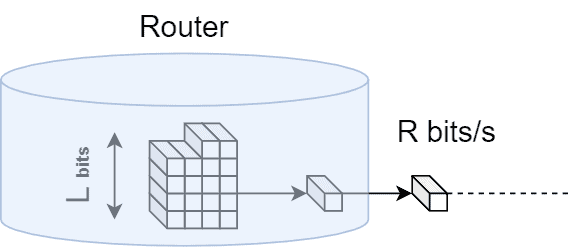1. 概述
网络是现代互联网应用的基石,用户体验在很大程度上依赖于网络的性能与稳定性。
然而,网络并非完美无瑕的系统。它存在诸如数据包延迟、冲突和丢失等问题。因此,我们在进行网络性能评估时,必须将这些现象纳入考虑范围。
本文将介绍数据包传输时间的概念,并探讨如何对其做一个近似估算。
2. 基础概念
多个因素会影响数据包的传输时间。本文将重点介绍以下四个主要延迟项:
- 处理延迟(Processing Delay)
- 排队延迟(Queuing Delay)
- 传输延迟(Transmission Delay)
- 传播延迟(Propagation Delay)
网络可以被建模为图结构,节点代表设备(如计算机、路由器、交换机等),边代表这些设备之间的链路。
为便于理解,我们先考虑如下图所示的简单网络模型,假设一个数据包刚刚到达节点 A,准备传往节点 B:

从 A 到 B 的所有可能延迟,都可以推广到更复杂的路径中。
3. 处理延迟
数据包到达节点 A 后,首先需要解析其头部信息:
- 检查并纠正在传输过程中可能出现的比特错误
- 分析头部信息以确定数据包应转发到哪个链路才能到达节点 B
这一步非常关键,因为当前节点可能连接多个设备。确定转发链路后,数据包将被放入队列中,等待传输。
4. 排队延迟
每个路由器内部都有一个缓冲区,用于存放已处理但尚未传输的数据包。
由于路由器一次只能传输一个数据包,如果新数据包到达时正在传输其他数据包,则该数据包必须在缓冲区中排队等待:

该缓冲区即为“队列”。路由器通常采用“先进先出”(FIFO)策略进行数据包调度。
排队延迟可从几微秒到毫秒级不等,具体取决于网络流量。在网络高峰期,排队延迟可能显著影响数据包的总延迟,尤其是当数据包丢失导致重传时。
5. 传输延迟
我们在本文中多次使用“传输”一词来描述数据包从节点 A 传到节点 B 的全过程。但严格来说,传输延迟指的是将整个数据包逐比特发送到链路上所需的时间。
这种延迟取决于链路的传输速率。例如,一个包含 L 个比特的数据包,通过传输速率为 R 的链路,其传输延迟为 L/R:

6. 传播延迟
最后一个要介绍的延迟是传播延迟。顾名思义,它是一个比特从节点 A 到达节点 B 所需的时间。
传播延迟取决于两个因素:
- 节点之间的距离 d
- 该传输介质的传播速度 v
传播速度通常非常快,一般在 0.6c 到 1c 之间,其中 c = 3×10⁸ m/s 为光速。
7. 几点说明
数据包在一个节点上的总延迟是上述所有延迟的总和:
$$ d_{tot} = d_{proc} + d_{queue} + d_{trans} + d_{prop} $$
但在实际应用中,并非所有项都同等重要,具体取决于场景。
- 传播延迟在局域网中可以忽略不计,但在卫星链路中影响显著
- 传输延迟在现代高速网络(如千兆以太网或光纤)中通常不是问题,但在低速链路(如拨号 Modem)中影响较大
- 处理延迟通常由专用硬件处理,因此在实践中影响较小
- 排队延迟是最关键的变量,其影响取决于队列中数据包的位置。第一个数据包可立即传输,第十个则需等待前九个传输完毕
因此,我们通常用期望值来描述排队延迟。
8. 示例分析
我们通过一个数值问题来巩固前面学到的概念。
8.1 问题描述
- 数据包长度:L = 500 bits
- 链路速率:R = 1 Mbps
- 每波次数据包数:N = 100
- 每波次到达间隔:0.05 秒
- 忽略处理延迟
问题:
- 一个数据包的平均排队延迟是多少?
- 如果节点 A 与 B 相距 100 km,传播速度为 2.5×10⁸ m/s,数据包到达 B 的平均时间是多少?
8.2 解答
8.2.1 传输延迟计算
$$ d_t = \frac{L}{R} = \frac{500}{10^6} = 0.0005\ s $$
第一个数据包无需排队,第二个需等 0.0005 s,第三个需等 2×0.0005 s,以此类推。
第 100 个数据包将在 100 × 0.0005 = 0.05 s 后发送完毕,刚好在下一波到来前完成。
8.2.2 平均排队延迟计算
$$ \tilde{d_q} = \frac{1}{N} \cdot d_t \cdot \sum^{N-1}_{n=0} n = \frac{1}{100} \cdot 0.0005 \cdot \frac{100×99}{2} = 0.02475\ s $$
8.2.3 传播延迟计算
$$ d_p = \frac{d}{v} = \frac{100×10^3}{2.5×10^8} = 0.0004\ s $$
8.2.4 总延迟计算
$$ d_{tot} = \tilde{d_q} + d_t + d_p = 0.02475 + 0.0005 + 0.0004 = 0.02565\ s $$
9. 小结
我们讨论了影响数据包总传输时间的主要因素,分析了每种延迟的来源及其在实际应用中的重要性,并通过一个数值问题加深了对这些概念的理解。
理解这些延迟对于网络性能优化、QoS 保障、以及分布式系统设计具有重要意义。✅
💡 踩坑提醒: 在实际网络监控中,排队延迟是最难预测且影响最大的因素之一,建议在网络拥塞测试中重点关注。